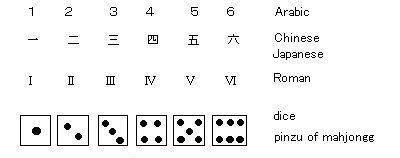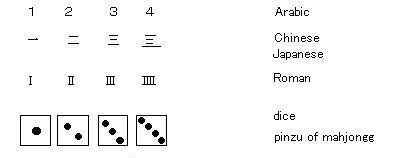Between 3 and 4, there is a split, about shape of numeric character,( 3 と 4 の間に、数字の形に関する割れ目あり)
Cognition of Number, Index, 数に関する認知, インデックス へ
-----
2024.4.1 presented in internet World Wide Web
2024.7.5 presented in [note] ( //note.com/runningWater/]
-----
In our daily lives, we use numbers in various ways. For example, when we buy something, we recognize and use numbers, in the form of monetary values, and when we move, we recognize and use numbers, in the form of time and the time required for moving.
我々は、日常生活を送る中に、様々の形で、数というものを、使用している。例えば、物を買う時には、金額という形で、数を認知し、使用しているし、移動する際には、時刻や移動の所要時間、という形で、数を認知し、使用している。
In those situations, the numbers that appear frequently, are the natural numbers (1,2,3...).
それらの場面において、頻繁に登場する数は、自然数(すなわち、1,2,3...)であろう。
By paying attention to the shape of the symbols (i.e., numeric character), used to denote these natural numbers, I think, it is possible to divide the (all) natural numbers, into two subsets, as follows.
この自然数を表記するための記号(すなわち、数字)の形に注目する事により、自然数(全体)を、以下のような、2つの部分集合に分割することが可能だと、私は考える。
Group_1_3 , [1] and [2] and [3]
Group_4_∞ , [4] and [5] and [6] and []...(That is, a natural number greater than or equal to 4, すなわち、 4 以上の自然数)
In this context, I have used the expression, "There is a split between [3] and [4], regarding the shape of numeric character".
この文脈をもってして、「[3]と[4]の間に、数字の形に関する割れ目あり」、と、表現したのである。
Here are my reasons, for thinking that way, (as described below).
私がそのように考えた理由を、以下に述べる。
----------
2. Let's look at the symbols for numbers. 数を表す記号に注目
First, please see the figure below (Fig. 2.1).
まず、下の図(Fig 2.1)を見ていただきたい。

Let's look at the [symbols for numbers (Chinese)], in the figure.
[The symbol, used to denote the number [1]] is [one horizontal line].
[The symbol, used to denote the number [2]] is [two horizontal lines (drawn parallel)].
[The symbol, used to denote the number [3]] is [three horizontal lines (drawn parallel)].
図中の、[漢数字 (Chinese)]に注目してみよう。
[1]という数値を表記するために使用される記号は、[1 本の水平線] である。
[2]という数値を表記するために使用される記号は、[2 本の水平線(平行に引かれた)] である。
[3]という数値を表記するために使用される記号は、[3 本の水平線(平行に引かれた)] である。
Next, let's look at the [symbols for numbers Roman)], in the figure.
[The symbol, used to denote the number [1]] is [1 vertical line + 2 horizontal short lines].
[The symbol, used to denote the number [2]] is [2 vertical lines (drawn parallel) + 2 horizontal short lines].
[The symbol, used to denote the number [3]] is [3 vertical lines (drawn parallel) + 2 horizontal short lines].
次に、図中の、[ローマ数字(Roman)]に注目してみよう。
[1]を表記するために使用される記号は、[1 本の垂直線 + 2 本の短い水平線] である。
[2]を表記するために使用される記号は、[2 本の垂直線(平行に引かれた) + 2 本の短い水平線] である。
[3]を表記するために使用される記号は、[3 本の垂直線(平行に引かれた) + 2 本の短い水平線] である。
In "dice" or "pinzu of mahjongg" (Note 1)
[The symbol, used to denote the number [1]] is [1 circle].
[The symbol, used to denote the number [2]] is [2 circles](arranged in a row).
[The symbol, used to denote the number [3]] is [3 circles](arranged in a row).
[サイの目] あるいは [ピンズ(マージャン)] では(注1)
[1]を表記するために使用される記号は、[1 個の円形] である。
[2]を表記するために使用される記号は、[2 個の円形(一列に並べられた)] である。
[3]を表記するために使用される記号は、[3 個の円形(一列に並べられた)] である。
As we have seen above, for values [1] to [3],
[The number of symbols is increased by one, and the added lines or circles are parallel or in a row, with the others.]
Thus, it is a change in form, with [a monotonous, increasing trend in symbols].
以上に見たように、数値[1] から 数値[3] までにおいては、
[記号の個数が、1 個 づつ増えていき、かつ、書き足された線や円は、他のそれらと平行、あるいは一列に並ぶ」
というような、、[単調な、記号の増加の傾向]を伴う、形態の変化になっている。
Note that, Arabic numerals were excluded from consideration here.
なお、ここでは、アラビア数字(Arabic)は、考慮の対象外とした。
Now, let's use the following definitions.
[The group of symbols, used to denote natural number values in the range [1] to [3]] is denoted as [Group_1_3].
[The group of symbols, used to denote the values of natural numbers in the range [4] and higher] is denoted as [Group_4_∞].
さて、以下のように、定義するとしよう。
[1] から [3] までの範囲の、自然数の値を表記するために使用される記号群を、[Group_1_3] とし、
[4] 以上の、自然数の値を表記するために使用される記号群を、[Group_4_∞] とする。
Comparing [Group_1_3] and [Group_4_∞], we can see that, there is a significant difference in the way, the symbols change form. That is,
The [monotonous, increasing trend of symbols] observed in [Group_1_3], suddenly disappears, as soon as entering [Group_4_∞].
[Group_1_3] と [Group_4_∞] を比較してみると、記号の形態の変化のしかたに大きな違いがあることが分かる。すなわち、
[Group_1_3] において観察された、[単調な、記号の増加の傾向] が、[Group_4_∞]に入るやいなや、突然、見られなくなっている。
To further clarify, what I am trying to say, I have prepared the figure below.
私がいったい何を言いたいのか、それを、更に明らかにするために、下図を、用意した。

Why couldn't it have been a symbol of shape, as in [Fig 2.2]? Why couldn't it be like the shape above? Under what circumstances, would the first users of these numerals have chosen to use the numerals [4] in the shape shown in [Fig. 2.1], instead of the shape shown in [Fig. 2.2]?
いったいなぜ、[Fig 2.2]のような、形態の記号であってはならなかったのか? なぜ、[Fig 2.2]のようにはならなかったのだろうか? いったい、どのような事情があって、これらの数字記号を最初に使った人々は、[4] という数値を表す記号を、[Fig 2.2] にあるような形にはせずに、[Fig 2.1] にあるような形に、したのであろうか?
----------
3. Is [the split between [3] and [4], regarding the shape of numeric character] common to all human beings? [[3]と[4]の間にある、数字の形に関する割れ目] は、人類が共通に持っているものなのか?
As seen above, the following phenomena,
Between [Group_1_3] and [Group_4_∞], there is a [split, regarding the shape of numeric character] (significant differences in the morphological appearance of the symbols).
is common to both China and Rome, which are geographically distant from each other.
I am greatly interested in this phenomenon.
以上に見たように、
[Group_1_3] と [Group_4_∞] の間に、[数字の形に関する割れ目](記号の形態変化の様の、顕著な違い)が存在する
という現象が、地理的に遠く隔たった中国とローマに、共通に見られる、という事になるのだ。
この現象に、私は大いに興味をそそられるのである。
Perhaps, this
[the split between [3] and [4], regarding the shape of numeric character]
is caused by some property or structure of the cerebrum of the human species?
もしかしたら、この
[[3]と[4]の間にある、数字の形に関する割れ目]
は、人間という動物種の持つ大脳の何らかの性質、あるいは構造により生じたのものなのだろうか、と、私は考える。
----------
4. Consideration regarding the cause of the existence of split, 割れ目が存在する原因についての考察
I think that, the [existence of this split] is deeply related to the [ability of identifying , at a glance] ( of human ).
私は、この割れ目の存在 は、 (人間の) [パット見 の 識別能力]と、深いかかわりがあるのでは、と思う。
Suppose that,
[a piece of paper, with several horizontal or vertical lines drawn on it] is presented in front of you, for about a second.
And then, the paper is immediately retracted, and disappears from your field of vision.
今、水平線、あるいは垂直線が、何本か描かれた紙が、あなたの目の前に1秒くらい提示された後、すぐに引っ込められて、あなたの視野から消えたとしよう。
In such a [discriminating at a glance] situation, would you be able to correctly identify the number of lines on the paper?
そのような、[パット見]の状況において、あなたは、その紙の上に描かれている線の本数を、正しく識別できるだろうか?
Case (1), You probably would not mistake ( on the discriminating at a glance situation ) [a paper with only one line drawn on it] for "two lines" or "nothing drawn on the paper", unless you are very fatigued or under the influence of intense sleepiness.
Case (2), You probably would not mistake [a paper with two lines on it] for "three lines" or "one line drawn on the paper".
Case (3), You probably (???) would not mistake [a paper with three lines on it] for "four lines" or "two lines drawn on the paper",
Case (4), You probably (??????) would not mistake [a paper with four lines on it] for "five lines" or "three lines drawn on the paper",
Case (5), You probably (?????????) would not mistake [a paper with five lines on it] for "six lines" or "four lines drawn on the paper",
ケース(1), 線が 1 本だけ描かれている紙を、[パット見]でもって、「2 本の線が描かれている」、あるいは、「紙の上には何も描かれていない」と見誤ることは、よほど疲労がたまっているか、強烈な眠気に影響されているのでもない限り、おそらく無いだろう。
ケース(2), 2 本の線が描かれている紙を、[パット見]でもって、「3 本の線が描かれている」、あるいは、「1 本の線が描かれている」と見誤ることは、おそらく無いだろう。
ケース(3), 3 本の線が描かれている紙を、[パット見]でもって、「4 本の線が描かれている」、あるいは、「2 本の線が描かれている」と見誤ることは、??? おそらく???
ケース(4), 4 本の線が描かれている紙を、[パット見]でもって、「5 本の線が描かれている」、あるいは、「3 本の線が描かれている」と見誤ることは、?????? おそらく??????
ケース(5), 5 本の線が描かれている紙を、[パット見]でもって、「6 本の線が描かれている」、あるいは、「4 本の線が描かれている」と見誤ることは・・・?????????
What is the cause of [the split between [3] and [4], regarding the shape of numeric character]?
I think that,
[The clue to solving this] may lie, in
[the limitation of [the ability of identifying the number of lines , at a glance]]( of human ).
[[3]と[4]の間にある、数字の形に関する割れ目] の原因は、いったい何か?
これを解くための手がかりが、
[パット見 によって、線の本数を識別する、能力]の限界
の中にあると、私は考える。
If, four parallel [horizontal lines] (or [vertical lines]) were used to represent the [number [4]], it would be easy to misidentify the number, as [3] or [5]. Therefore, the ancient Chinese and Romans may have adopted a symbol system, in which [there is a split between [3] and [4]], as we have seen above.
[4] という数字を表記するのに、水平線(垂直線)を、4 本、平行に描いたような記号を使っていたのでは、うっかりすると、それを、[3]、あるいは、[5]であると、誤認識(見誤り)しやすい。ゆえに、古代の中国人や、ローマ人は先に見たように、[3]と[4]との間に割れ目が存在するような記号の体系を、採用したのかもしれない。
[the limitation of [the ability of identifying the number of lines , at a glance]] may be able to pull it upward, with training. I wonder, how many, a bank teller can recognize the number of bills, at a glance.
[[パット見によって、線の本数を識別する、能力]の限界] は、訓練により、上方に引き上げることが、できるのかもしれない。銀行の窓口で勤務している人は、いったいどれくらいまでなら、パット見でもって、紙幣の枚数を認識できるのだろう?
----------
5. subitizing range(瞬間認知可能範囲)
In psychology, [the limitation of [the ability of identifying the number of lines , at a glance]] seems to be expressed
by the term, [subitizing range].
心理学においては、 [[パット見 によって、線の本数を識別する、能力]の限界] は、
[subitizing range](瞬間認知可能範囲)
という用語でもって、表現されているようだ。
Studies have been done on this, not only in humans, but also in chimpanzees.
これに関しては、人間だけではなく、チンパンジーのそれに関しても、研究が行われているようだ。
Perhaps, animals (including humans) started counting, using [discriminating ability at a glance].
もしかしたら、動物(人間も含む)は、[パット見によって、識別する能力]でもって、数を数え始めたのかもしれない。
You may be able to obtain information on these matters, by searching in Internet, using a combination of the following keywords as appropriate.
以下のキーワードを適宜、組み合わせて使用して、ネット検索を行えば、これらの事柄に関する情報を、得ることが、できるかもしれない。
[subitizing]
[number]
[subitizing range]
[counting]
[estimation]
[enumeration chimpanzee]
----------
(Note 1) If the form of [pinzu of mahjongg] is strictly described, it should be called [concentric circles] rather than [circle]".
(注1)マージャンのピンズの「紋」を厳密に表現するならば、「円形」ではなく、「同心円」というべきであろう。
この記事が気に入ったらサポートをしてみませんか?
